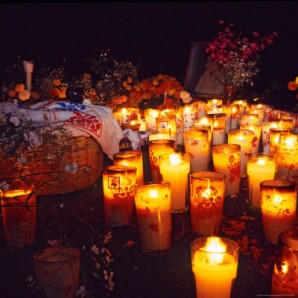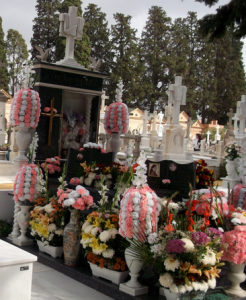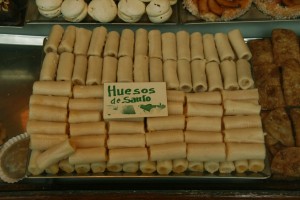
Candles are lit in respect of the departed on Día de Todos los Santos.
Well, It’s that time of year again as we find Halloween impending on us quicker than you can say ‘trick or treat’.
If you already live in Spain or have visited during this time of year then you may know that the traditional ‘Spanish Halloween’ does not necessarily revolve around witches, devils and pumpkins. Far from being a commercial holiday and certainly without the same lucrative hype as in the USA and some of its European neighbours, Spain has its own unique customs when it comes to celebrating All Hallows’ Eve…Better celebrated on 1 November as All Saint’s Day (Día de Todos los Santos), and sometimes known as ‘Day of the Dead’ the ‘Spanish Halloween’ is a joyous time all about reminiscing, paying respect to the deceased and celebrating the continuity of life.
Traditionally in Spain this National Holiday is a three day celebration starting on 31 October with Día de las Brujas (Day of the Witches), continuing with Día de Todos los Santos (All Saints Day) on 1 November, and ending on 2 November with Día de los Muertos (Day of the Dead).
On the public holiday of Día de Todos los Santos, schools and most businesses will close and traditionally Spanish families will gather at local graveyards to honour the departed. They adorn family tombstones with magnificent flowers and rejoice and socialise with Holy water, food and drink.

Elaborate wreaths are displayed on graves for Día de Todos los Santos
Mass is performed in the cemetery several times throughout the day. Parades and fireworks may also be organised, and many people, particularly down here on the sun-soaked Costa del Sol, get together at local parks to hold barbecues, roast chestnuts (castañas) and drink raisin brandy. But be sure to check with your local town hall first as they regulate the use of specific barbecuing areas and the times that their use is permitted
It may seem strange to some, but this celebration is in no way a morbid occasion – quite the opposite in fact – a time for families and communities to come together and remember their loved ones in a jovial, sociable atmosphere.
You may also get an opportunity (which, by the way, I highly recommend) to try ‘Huesos de Santo’ (Saints’ Bones), which is a (delicious!) traditional sweet eaten during this holiday made out of marzipan and ‘dulce de yema’ (sweet egg yolks). Another traditional delicacy you may find is ‘Buñuelos de Viento’ (literally, Puffs of Wind), which are basically little doughnuts sprinkled with cinnamon and sugar.

Huesos de Santo are one of the most traditional of the sweets that are eaten on All Saints’ Day
One of the most interesting places to be in for All Saints’ Day is Cádiz. All Saints’ Day in Cádiz is a little different: known as ‘Tosantos’, the Gaditanos (locals of Cádiz) go all out with parades, candle-lit processions, fireworks, colourful street markets selling all types of local produce and all sorts of children’s activities. Festivities are sure to be in abundance as the holiday is celebrated there for up to a week.
Here in Spain the commercial importance of ‘Halloween’ is still a fairly new phenomenon but over the last few years with the rise of large expat communities from all over the world Spain has unavoidably adopted certain ‘foreign’ traditions with shops stocking ghoulish costumes and bars swathed in macabre decor. So you won’t have to look too far if you’re after a ghostly fix.
That said, in this modern and increasingly secular age, All Saints’ Day is a powerful reminder of the importance of religion and family within Spanish culture. So in a country with such traditional values the only real spirits you’re sure to find will be in your local bar and go down well with a tonic…
This just leaves me to say Happy Halloween from everyone at VIVA and enjoy your holiday, however you intend to celebrate!
 en
en



 Vlaams-Nederlands
Vlaams-Nederlands
0 Comments
Leave a Comment
DISCLAIMER
The opinions and comments expressed by contributors to this Blog are theirs alone and do not necessarily reflect the views of VIVA Homes Under the Sun Ltd, any of its associated companies, or employees; nor is VIVA to be held responsible or accountable for the accuracy of any of the information supplied.
Have you got something to say?